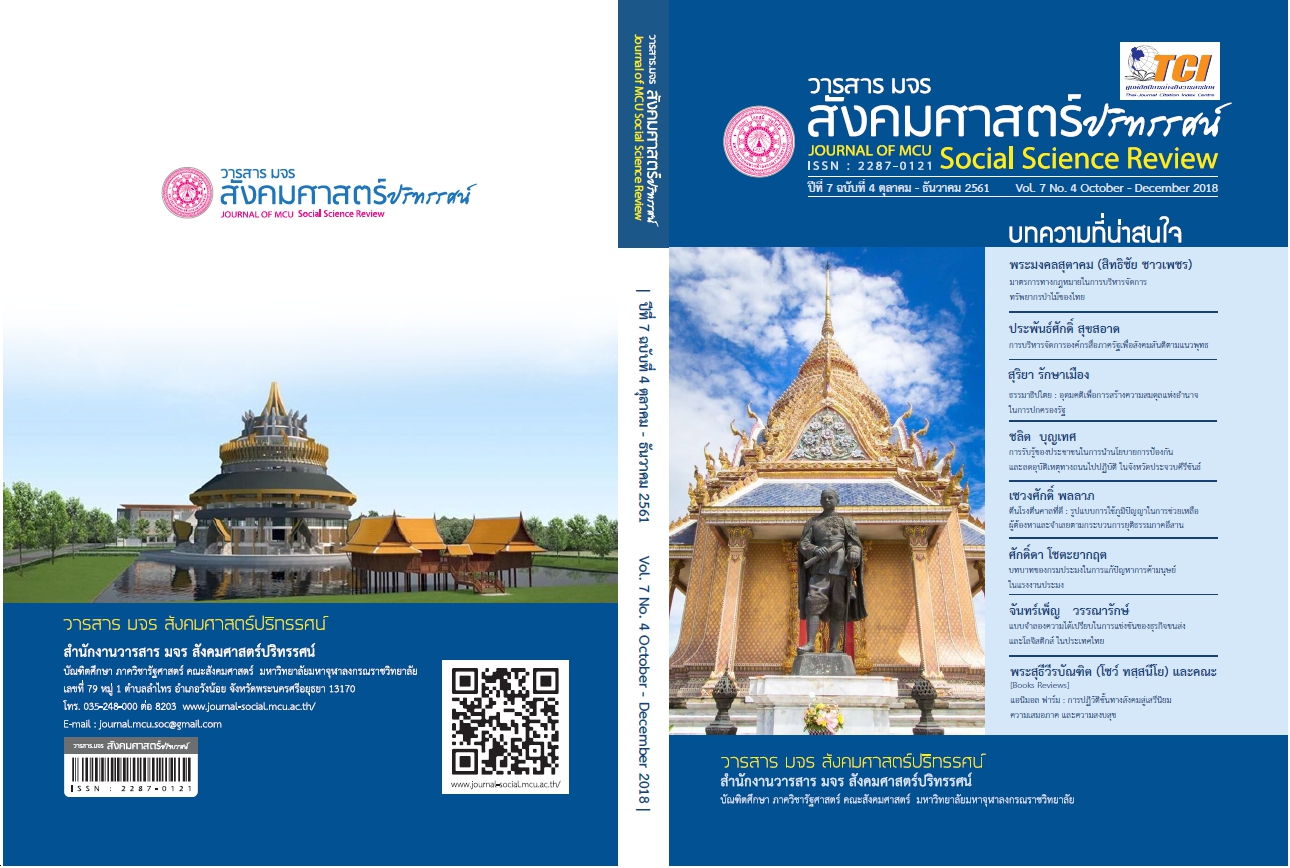ตีนโรงตีนศาลที่ดี : รูปแบบการใช้ภูมิปัญญาในการช่วยเหลือผู้ต้องหาและจำเลย ตามกระบวนการยุติธรรมภาคอีสาน
คำสำคัญ:
ตีนโรงตีนศาล, ผู้ต้องหา, จำเลย, รูปแบบการใช้ภูมิปัญญา, กระบวนการยุติธรรมบทคัดย่อ
บทความนี้ มีความมุ่งหมาย 3 ประการ คือ เพื่อศึกษาความเป็นมาของตีนโรงตีนศาลในการช่วยเหลือผู้ต้องหาและจำเลยในกระบวนการยุติธรรมภาคอีสาน เพื่อศึกษาสภาพปัจจุบันและปัญหาของตีนโรงตีนศาลในการช่วยเหลือผู้ต้องหาและจำเลยในกระบวนการยุติธรรมภาคอีสาน เพื่อศึกษารูปแบบการใช้ภูมิปัญญาของตีนโรงตีนศาลที่ดีในการช่วยเหลือผู้ต้องหาและจำเลยในกระบวนการยุติธรรมภาคอีสาน โดยใช้วิธีวิจัยเชิงคุณภาพ กลุ่มตัวอย่างในการวิจัย ใช้วิธีเลือกแบบเจาะจง ประกอบด้วยกลุ่มผู้รู้ กลุ่มผู้ปฏิบัติ และกลุ่มผู้ให้ข้อมูลทั่วไป จำนวน 93 คน เครื่องมือที่ใช้ในการเก็บข้อมูล ได้แก่ แบบสังเกตแบบมีส่วนร่วม แบบสัมภาษณ์เชิงลึก และแบบบันทึกผลการสนทนากลุ่ม แล้วนำข้อมูลทั้งหมดมาวิเคราะห์และนำเสนอผลการวิจัยด้วยวิธีพรรณนาวิเคราะห์
ผลการวิจัยพบว่า
- ความเป็นมาของตีนโรงตีนศาลในการช่วยเหลือผู้ต้องหาและจำเลยในกระบวนการยุติธรรมอีสาน พบว่า “ตีนโรงตีนศาล” เป็นภาษาชาวบ้านที่ใช้เรียกบุคคลที่ประกอบอาชีพอยู่ในบริเวณศาล ด้วยวิธีการช่วยเหลือผู้ต้องหาและจำเลยเขียนคำร้อง
คำแถลง จัดเอกสารที่ใช้ประกอบคำร้อง ช่วยหาหลักทรัพย์ และอื่นๆตามกระบวนการยุติธรรม โดยมีค่าตอบแทนตามความพอใจของผู้ใช้บริการ อาชีพตีนโรงตีนศาลมีมายาวนานคู่กันกับศาล จากอดีตจนถึงปัจจุบัน
- สภาพปัจจุบันและปัญหาของตีนโรงตีนศาล ในการช่วยเหลือผู้ต้องหาและจำเลย พบว่า คดีความในศาลจังหวัดแต่ละแห่งเพิ่มมากขึ้น การยื่นคำร้องขอให้ปล่อยผู้ต้องหาและจำเลยชั่วคราว ส่วนใหญ่ขาดหลักทรัพย์ โดยเฉพาะคดียาเสพติดซึ่งมีความเสี่ยงสูง หาหลักทรัพย์และคนค้ำประกันยาก เคยมีผู้ต้องหาหลบหนีหลังจากประกันตัว ต้องเสียเวลาและค่าใช้จ่ายในการติดตาม แต่ตีนโรงตีนศาลยังกล้าเสี่ยง เพื่อให้ความช่วยเหลือผู้ต้องหาและจำเลย
- รูปแบบการใช้ภูมิปัญญาของตีนโรงตีนศาลที่ดีในการช่วยเหลือผู้ต้องหาและจำเลยในกระบวนการยุติธรรมภาคอีสาน พบว่า มี 3 รูปแบบ คือ 1) ตีนโรงตีนศาลเข้าไปแนะนำตัวเองกับผู้ต้องหาและจำเลย เพื่อให้ผู้ใช้บริการเกิดความมั่นใจ 2) ผู้ที่ได้รับความเดือดร้อน เข้ามาพบตีนโรงตีนศาล เนื่องจาก ต้องการความช่วยเหลือ 3) การแนะนำระบบเครือข่าย ประกอบด้วย ตำรวจ เจ้าหน้าที่ศาล และทนายความ ซึ่งบุคคลดังกล่าว ประกอบอาชีพอยู่คู่กันมายาวนาน อาจกล่าวได้ว่า แยกกันไม่ออก ทำงานร่วมกันแบบส่งต่อ หรือเรียกว่า “เครือข่าย”
เอกสารอ้างอิง
Bunpeng Phusaenbai. Interview. (4 July 2016). At house no. 9, Village no. 2, PhonThong Sub- District, Mueang District, Kalasin Province.
Chaiyuth Watcharanon.(2005). Code of Laws; Civil Procedure, Criminal Procedure, Statute of Courts of Justice. Bangkok:Bandistakson Publisher.
Jutharat Euaumnuay. (1998) Justice Process of Reconciliation: The Paradigm of the Thai Judicial Process. Bangkok: Thammasat University.
Kamtorn Kamprasert. (1977). History of Laws. Bangkok Metropolis: Ramkhamhaeng University Printing House.
Natpakit Puekpong. Interview. (19 March 2016). At Court of Mahasarakham Province, Mueang District. Mahasarakham.
Purachai Phiamsomboon. (1988). Basic Crime and Procedure of Justice. Bangkok: Karnpimnakorn Limited Partnership.
Somkieat Paetkhun. (2005). Development of the Conciliation Model in the Prosecutor’s Procedure. Khon Kaen: Khon Kaen University.
Songkoon Chantachon. (2010). Qualitative Research on Advanced Culture (Practical section). Mahasarakham Province, Mahasarakham University Press.
Songsiri Saprasert. (1999). Transferred Description of Knowledge of Folk Wisdom. The Transference of Knowledge of Wisdom Holders. Bangkok : Mahidol University.
ดาวน์โหลด
เผยแพร่แล้ว
รูปแบบการอ้างอิง
ฉบับ
ประเภทบทความ
สัญญาอนุญาต
ลิขสิทธิ์ (c) 2019 วารสาร มจร สังคมศาสตร์ปริทรรศน์

อนุญาตภายใต้เงื่อนไข Creative Commons Attribution-NonCommercial-NoDerivatives 4.0 International License.
เพื่อให้เป็นไปตามกฎหมายลิขสิทธิ์ ผู้นิพนธ์ทุกท่านต้องลงลายมือชื่อในแบบฟอร์มใบมอบลิขสิทธิ์บทความให้แก่วารสารฯ พร้อมกับบทความต้นฉบับที่ได้แก้ไขครั้งสุดท้าย นอกจากนี้ ผู้นิพนธ์ทุกท่านต้องยืนยันว่าบทความต้นฉบับที่ส่งมาตีพิมพ์นั้น ได้ส่งมาตีพิมพ์เฉพาะในวารสาร มจร สังคมศาสตร์ปริทรรศน์ เพียงแห่งเดียวเท่านั้น หากมีการใช้ภาพหรือตารางหรือเนื้อหาอื่นๆ ของผู้นิพนธ์อื่นที่ปรากฏในสิ่งตีพิมพ์อื่นมาแล้ว ผู้นิพนธ์ต้องขออนุญาตเจ้าของลิขสิทธิ์ก่อน พร้อมทั้งแสดงหนังสือที่ได้รับการยินยอมต่อบรรณาธิการ ก่อนที่บทความจะได้รับการตีพิมพ์ หากไม่เป็นไปตามข้อกำหนดเบื้องต้น ทางวารสารจะถอดบทความของท่านออกโดยไม่มีข้อยกเว้นใดๆ ทั้งสิ้น





